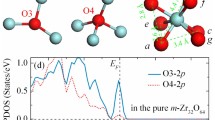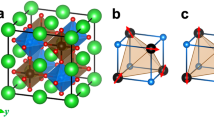Abstract
The transport properties of sodium superoxide (NaO2) are governed by the transfer of charge between O2− complexes. Although it goes through a plethora of structural phase transitions, its electronic and magnetic ground state remains shrouded in mystery. In this work, we perform first-principles density functional theory (DFT) calculations to understand the relationship between electronic structure and the reason for the non-observation of an antiferromagnetic (AFM) ground state in NaO2 vis-a-vis in KO2. In the cubic phase, uniform < Na–O-Na bond angles result in high symmetry and hence degeneracy in the O-2p orbitals. The freely rotating O2− molecules result in orbital degeneracy and hence paramagnetism at room temperature. Although the degeneracy between the bonding and anti-bonding orbitals of O2 dimers is lifted in the pyrite phase, the degeneracy between σ (σ*) and π (π*) states is still maintained and hence orbital degeneracy is partially lifted as the dimers are restricted to four directions now. The O-π* states are localized in such a manner that results in a substantial magnetic moment in the π*-orbital. The < O–Na–O bond angle (= 180°) in the c-axis facilitates a superexchange mechanism and thereby the system should be AFM in the pyrite phase. In the marcasite phase, the O-atoms are aligned parallel in alternative planes. The preservation of degeneracy among the two π* orbitals leading to only long-range orbital ordering negates any chance of quasi-one-dimensional AFM spin chains in NaO2. The difference in magnetic ground states of NaO2 and KO2 arises due to the difference in the electrostatic repulsion between electrons of Na+ and K+ ions with the O2− dimers.
Graphical abstract













Similar content being viewed by others
Data availability
All the analyzed and generated data used for this study are available along with this manuscript.
Code availability
Not applicable.
References
Wriedt HA (1987) The Mg-O (magnesium-oxygen) system. Bull Alloy Phase Diagrams 8:234–246
Sangster J, Pelton AD (1992) The Li-O (lithium-oxygen) system. J Phys E 13:296–299
Hartmann P, Bender CL, Sann J, Durr AK, Jansen M, Janek J, Adelhelm P (2013) A comprehensive study on the cell chemistry of the sodium superoxide (NaO2) battery. Phys Chem Chem Phys 15:11661–11672
Hartmann P, Bender CL, Vracar M, Durr AK, Garsuch A, Janek J, Adelhelm P (2013) A rechargeable room-temperature sodium superoxide (NaO2) battery. Nat Mater 12:228–232
Bruce PG, Freunberger SA, Hardwick LJ, Tarascon JM (2011) Li-O2 and Li-S batteries with high energy storage. Nat Mater 11:19–29
Black R, Oh SH, Lee JH, Yim T, Adamas B, Nazar LF (2012) Screening for superoxide reactivity in Li-O2 batteries: effect on Li2O2/LiOH crystallization. J Am Chem Soc 134:2902–2905
Sun Q, Yang Y, Fu ZW (2012) Electrochemical properties of room temperature sodium-air batteries with nonaqueous electrolyte. Electrochem Commun 16:22–25
McCloskey BD, Garcia JM, Luntz AC (2014) Chemical and electrochemical differences in nonaqueous Li-O2 and Na-O2 batteries. J Phys Chem Lett 5:1230–1235
Arcelus O, Li C, Rojo T, Carrasco J (2015) Electronic structure of sodium superoxide bulk, (100) surface, and clusters using hybrid density functional: relevance for Na-O2 batteries. J Phys Chem Lett 6:2027–2031
Kang S, Mo Y, Ong SP, Ceder G (2014) Nanoscale stabilization of sodium oxides: implications for Na-O2 batteries. Nano Lett 14:1016–1020
Yang S, Siegel DJ (2015) Intrinsic conductivity in sodium-air battery discharge phases: sodium superoxide vs sodium peroxide. Chem Mater 27:3852–3860
Singh P, Gaur NK (2007) Lattice dynamics of sodium superoxide. Phys Lett A 371:349–353
Lee B, Seo DH, Lim HD, Park I, Park KY, Kim J, Kang K (2014) First-principles study of the reaction mechanism in sodium-oxygen batteries. Chem Mater 26:1048–1055
Hartmann P, Grübl D, Sommer H, Janek J, Bessler WG, Adelhelm P (2014) Pressure dynamics in metal-oxygen (metal-air) batteries: a case study on sodium superoxide cells. J Phys Chem C 118:1461–1471
Solovyev IV, Pchelkina ZV, Mazurenko VV (2014) Magnetism of sodium superoxide CrystEnggComm 16:522–531
Tatara R, Leverick GM, Feng S, Wan S, Terada S, Dokko K, Watanabe M, Shao-Horn Y (2018) Tuning NaO2 cube sizes by controlling Na+ and solvent activity in Na-O2 batteries. J Phys Chem C 122(32):18316–18328
Han S, Cai C, Yang F, Zhu Y, Sun Q, Zhu YG, Li H, Wang H, Shao-Horn Y, Sun X, Gu M (2020) Interrogation of the reaction mechanism in a Na-O2 battery using in situ transmission electron microscopy. ACS Nano 14(3):3669–3677
Kim M, Min BI (2014) Temperature-dependent orbital physics in a spin-orbital-lattice-coupled 2p electron Mott system: The case of KO2. Phys Rev B 89: 121106 (R)
Knaflič T, Klanjšek M, Sans A, Adler P, Jansen M, Felser C, Arčon D (2015) One-dimensional quantum antiferromagnetism in the p-orbital CsO2 compound revealed by electron paramagnetic resonance. Phys Rev B 91:174419
Zumsteg A, Ziegler M, Kanzig W, Bosch M (1974) Magnetische und kalorische Eigenschaften von Alkali-Hyperoxid-Kristallen. Phys Condens Matter 17:267–291
Känzig W, Labhart M (1976) Molecular and magnetci order in alali hyperoxides: a short review op recent work. J Phys Colloq 37:C7-39-C7-45
Das SK, Lau S (2014) Archer LA (2014) Sodium-oxygen batteries: a new class of metal-air batteries. J Mater Chem A 2:12623
Ellis BL, Nazar LF (2012) Sodium and sodium-ion energy storage batteries. Curr Opin Solid State Mater Sci 16:168–177
Kundu D, Talaie E, Duffort V, Nazar LF (2015) The emerging chemistry of sodium ion batteries for electrochemical energy storage. Angew Chem Int Ed 54:3431–3448
Kwak WJ, Chen z, Yoon CS, Lee JK, Amine K, Sun YK, (2015) Nanoconfinement of low-conductivity products in rechargeable sodium-air batteries. Nano Energy 12:123–130
Ortiz-Vitoriano N, Batcho TP, Kwabi DG, Han B, Pour N, Yao KPC, Thompson CV, Shao-Horn Y (2015) Rate-dependent nucleation and growth of NaO2 in Na-O2 batteries. J Phys Chem Lett 6:2636–2643
Landa-Medrano I, Pinedo R, Bi X, de Larramendi IR, Lezama L, Janek J, Amine K, Lu J, Rojo T (2016) New insights into the instability of discharge products in Na-O2 batteries. ACS Appl Mater Interfaces 8(31):20120–20127
Sun B, Kretschmer K, Xie X, Munroe P, Peng Z, Wang G (2017) Hierarchical porous carbon spheres for high-performance Na-O2 batteries. Adv Mater 29(38):1606816
Liu C, Carboni M, Brant WR, Pan R, Hedman J, Zhu J, Gustafsson T, Younesi R (2018) On the stability of NaO2 in NaO2 batteries. ACS Appl Mater Interfaces 10(16):13534–13541
Zhao S, Wang C, Du D, Li L, Chou S, Li F, Chen J (2021) Bifunctional effects of cation additive on Na-O2 batteries. Angew Chem Int Ed 133(6):3242–3248
Nandy AK, Mahadevan P, Sen P, Sarma DD (2010) KO2: realization of orbital ordering in a p-orbital system. Phys Rev Lett 105:056403
Hohenberg P, Kohn W (1964) Inhomogeneous electron gas. Phys Rev B 136:B864
Kohn W, Sham LJ (1965) Self-consistent equations including exchange and correlation effects. Phys Rev 140:A1133
Perdew JP, Wang Y (1992) Accurate and simple analytic representation of the electron-gas correlation energy. Phys Rev B 45:13244
Anderson OK, Jepsen O (1984) Explicit, first-principles tight-binding theory. Phys Rev Lett 53:2571
Anderson OK (1975) Linear methods in band theory. Phys Rev B 12:3060
Ziegler M, Roesenfeld M, Känzig W, Fischer P (1976) Strukturuntersuchungen an alkalyhyperoxiden Helv Phys Acta 49:57–59
Acknowledgements
The authors thank the West Bengal State University, Kolkata-700126, India, and Department of Higher Education, W.B, India, for financial and infrastructure support to carry out this work. The authors also render thanks to Debabrata Samata and Subhajit Chaudhury, M.Sc. students in the Dept. of Physics, West Bengal State University for their assistance to carry out this work.
Funding
This research was supported by the West Bengal State University, Kolkata-700126, India, and the Department of Higher Education, Government of West Bengal, India.
Author information
Authors and Affiliations
Contributions
S. B.: Framed the works, calculations, simulations, investigations, conceptualization and writing-original draft. M.D.R.: Framed the works, calculations, simulations, investigations, project administration, supervision, technical support, writing-original draft.
Corresponding author
Ethics declarations
Ethics approval
Not applicable.
Consent to participate
Not applicable.
Conflict of interest
The authors declare no competing interests.
Additional information
Publisher's Note
Springer Nature remains neutral with regard to jurisdictional claims in published maps and institutional affiliations.
Rights and permissions
About this article
Cite this article
Biswas, S., De Raychaudhury, M. Quenching of magnetism in NaO2 due to electrostatic interaction induced partial orbital ordering. J Mol Model 28, 13 (2022). https://doi.org/10.1007/s00894-021-05008-4
Received:
Accepted:
Published:
DOI: https://doi.org/10.1007/s00894-021-05008-4




